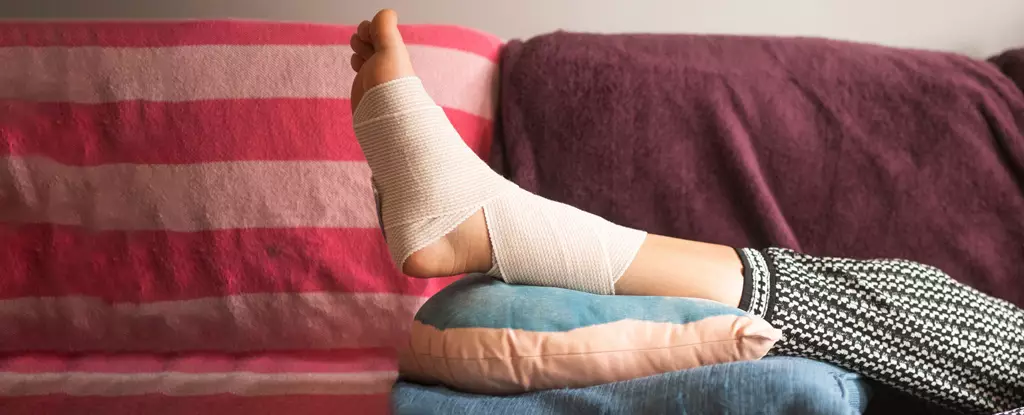In conventional terms, ankle sprains are often viewed as mere musculoskeletal injuries, localized and limited to the ankle joint itself. Yet recent advancements in neuroscience and movement studies suggest these injuries could be intricately connected to brain function and adaptation. This concept, known as neuroplasticity, posits that the brain is not only reactive but also adaptive in response to various injuries and changes in sensory input. When an individual experiences an ankle sprain, it’s not just the physical damage that warrants attention; underlying neural adaptations may also occur, impacting how pain and movement are perceived.
Research being conducted at institutions like the University of Canberra shows that these changes are more than theoretical. Graduate researcher Ashley Marchant’s work reveals that the way our lower limbs experience weight—particularly the load imposed on muscles—affects our movement accuracy. As the load moves closer to the normal gravitational pull of Earth, our capacity to gauge movement improves. However, when this load diminishes, our ability to sense and control movement deteriorates. Thus, it could be argued that how we perceive and respond to bodily movement is not solely dependent on the functioning of our muscles but is also heavily influenced by the brain’s adaptability.
Traditionally, sports medicine has focused intensively on physical rehabilitation through techniques like resistance training, cardiovascular fitness, and flexibility exercises to restore muscle function. However, this focus neglects a crucial factor: sensory input. The disparity between an athlete’s recovery from a physical injury and their actual readiness to return to play has significant implications. Even after what may appear to be complete physical healing, the risk of subsequent injuries can remain alarmingly high, with statistics suggesting that this risk could be between two to eight times greater than for those without a prior injury.
This reality highlights a hole in the current treatment methodology. The conventional paradigms of rehabilitation may be missing the broader picture, which encompasses how the brain processes and coordinates movement following an injury. By delving into sensory mechanisms that inform movement control, researchers are uncovering insights that could lead to more effective rehabilitation strategies. The balance between motor output and sensory input is not just arbitrary; it can fundamentally alter an athlete’s recovery trajectory.
In an effort to refine movement strategies, recent research has mapped the various sensory systems that feed information into our brains—the vestibular system (related to balance), visual cues, and proprioceptive feedback from the limbs. Understanding how well an individual processes information from these systems can inform personalized rehabilitation programs. For instance, astronauts, who experience significant sensory deprivation in zero-gravity environments, find that their normal balance and coordination skills deteriorate. Such insights underline the brain’s reliance on constant sensory input to maintain effective motor control.
In conditions of altered gravity, astronauts must quickly recalibrate their movement strategies upon returning to Earth or the Moon, processes that are often fraught with difficulties. Surprisingly, similar mechanisms may be at play in athletes recovering from leg injuries. If modified movement patterns, such as limping, lead to altered sensory input to the brain, this could create long-lasting changes in movement perception and control. These maladaptive responses could help explain why prior injuries seem to predispose individuals to future ones.
This intersection of sensory perception, movement control, and injury prevention opens a new frontier in both sports medicine and general health. The ability to assess sensory input quality emerges as a powerful tool for not just rehabilitating athletes but also for preventing injuries in the first place. Moreover, insights gained through these sensory assessments might also assist in identifying potential athletic talent early on.
In the context of aging populations, where the risk of falls significantly escalates, understanding sensory processing becomes paramount. Many seniors exhibit reduced physical activity—triggering the “use it or lose it” principle—which can lead to the degradation of essential movement perception and control systems. By harnessing precision health technologies and artificial intelligence, there is potential to develop customized interventions designed to suit individual needs, thereby transforming injury prevention and rehabilitation strategies.
Recognizing the intricate relationship between ankle injuries and brain adaptability prompts a shift in how we understand movement control. By prioritizing sensory input alongside physical rehabilitation, the potential for enhanced recovery and injury prevention is not merely hopeful; it is a necessary evolution in the medical approach to human movement.


Leave a Reply